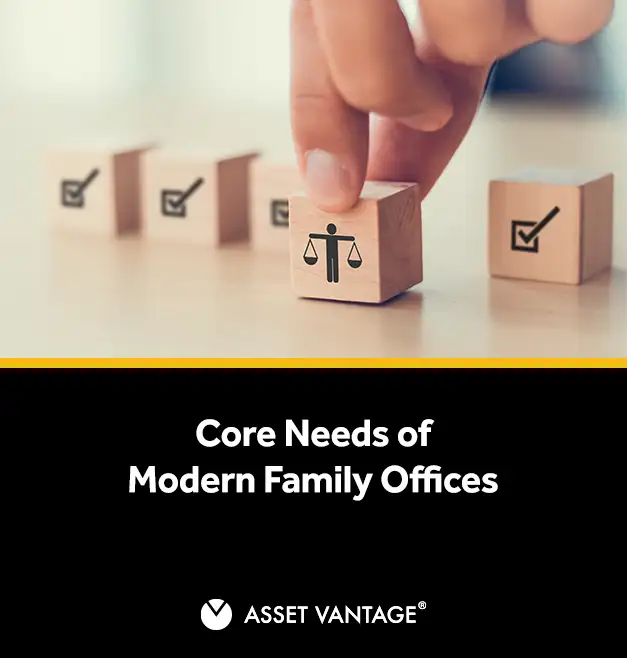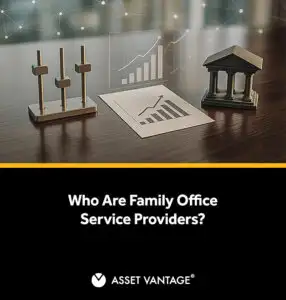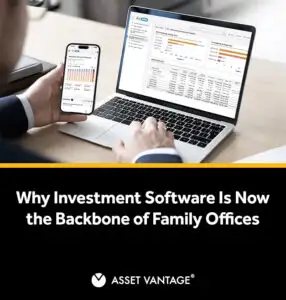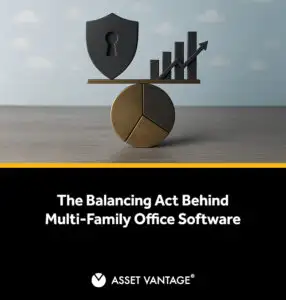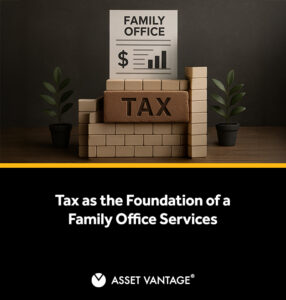Read Time17 Mins
- Core Needs Of Modern Family Offices
- Portfolio Management And Performance Reporting Requirements
- Investment Management, Data Aggregation, and Control
- Accounting Foundations For Complex Structures
- Managing Alternative Investments Effectively
- Document Management And Governance Controls
- Integration With External Wealth Systems
- Comparing Single-Family And Multi-Family Office Models
- Implementation And Adoption Roadmap
- Privacy, Controls, And Risk Management
- Outcomes And Measurable ROI
- Customization and Scalability
- User Experience
Core Needs Of Modern Family Offices
Operator Outcomes: Consolidated Reporting And Operational Efficiency
- A single view of wealth that integrates portfolio and financial data across private equity holdings, real estate, and liquid securities.
- Dashboards linking cash flows, expenses, and investment results to accountability metrics.
- Faster closes, freeing resources to focus on strategy instead of error correction.
Moving From Manual Processes To Automated Data Capture
- Data integration from custodians, banks, and administrators into standardized feeds.
- Automated handling of transactions, reducing mismatches and delays.
- Timely updates that extend reporting into investment portfolio analysis with advanced analytics.
Why Family Office Management Requires Specialized Software
- Normalizing financial data across asset classes for consistent reporting.
- Managing alternative assets with tools for capital calls, distributions, and valuations.
- Embedding governance frameworks, from document management to permissions, aligned to family structures.
Decision Criteria For Selecting The Right Family Office Software
- Data integration: Seamless aggregation across custodians, private equity funds, and real estate managers.
- Analytics capability: Advanced analytics to support investment portfolio analysis and risk oversight.
- Asset coverage: Managing alternative assets such as venture capital firms and private equity alongside traditional securities.
- Governance support: Permissions, document management, and reporting aligned with family members and advisors.
- Service scope: Wealth management services that improve the experience for principals and beneficiaries.
Portfolio Management And Performance Reporting Requirements
Consolidated Reporting Across Asset Classes And Entities
- Custodian and administrator feeds are consolidated into a single system.
- Capital calls, valuations, and distributions standardized for alternative assets.
- Transparency across asset classes, allowing family members and advisors to view holdings side by side.
- Automated reconciliations and reporting packs that reduce manual errors.
Performance Reporting For Investment And Wealth Management
Strong systems deliver:
- Cross-entity performance metrics across trusts, partnerships, and foundations.
- Scenario modeling that illustrates tactical decisions in relation to intergenerational wealth.
- Reporting outputs used by family office professionals for governance and tax planning.
Dashboards For Business Managers And Family Members
Key features include:
- Alerts and workflow automation for operators.
- High-level wealth summaries showing contributions from alternative investments.
- Integration with private wealth systems to ensure consistency across advisors.
Analytics For Portfolio Analysis And Risk Management
- Stress-testing exposures in private equity, real estate, and venture capital.
- Correlation analysis across multiple asset classes..
- Predictive models that forecast liquidity needs and governance outcomes.
Investment Management, Data Aggregation, and Control
How The Platform Integrates Data From Custodians, Banks, And Administrators
- Automated ingestion of statements and transaction feeds.
- Normalization of formats so financial data is ready for reporting and portfolio analysis.
- Secure storage that integrates with family office accounting software for enhanced compliance.
Automated Data Feeds Versus Manual Processes
- Daily reconciliations that remove manual data handling.
- Reduced dependency on staff intervention, streamlining workflows for both single-family offices and multi-family offices.
- Integration with cloud accounting software ensures that reconciliations are seamlessly integrated into ledgers.
Automation enables reporting to scale without requiring additional headcount.
Normalizing Portfolio Data And Wealth Data For Analysis
- Consistent classification of alternative assets, private equity, and real estate holdings.
- Standardization across asset classes to enable performance comparisons.
- Outputs supporting investment management and wealth management services in real time.
Data Quality Checks For Operations And Client Service
- Automated validations that detect mismatches or missing feeds.
- Audit trails linked to family office accounting software.
- Outputs tailored for both operator dashboards and family member reports.
Accounting Foundations For Complex Structures
General Ledger And Transaction Processing For Financial Management
- A chart of accounts designed for complex financial structures and cross-entity reporting.
- Transaction processing for distributions, intercompany flows, and allocations.
- Audit-ready records that link directly to reporting and compliance.
Bill Pay, Expense Management, And Workflow Automation
- Automated routing of payments for review and approval.
- Integration with custodial data for instant reconciliations.
- Expense tracking tied to reporting and client service.
Accounting Software For Single-Family And Multi-Family Offices
- Permissions aligned with family members, advisors, and auditors.
- Consolidated reporting across entities without compromising privacy.
- Controls that let one office manage multiple families with the separation of records.
Cloud Accounting Software And Integration Options
- Direct connections to banks, custodians, and administrators.
- Links between ledgers, private wealth systems, and reporting engines.
- Role-based access for distributed family office professionals.
Managing Alternative Investments Effectively
Alternative Assets In Private Equity And Venture Capital
- Consolidated tracking of commitments and distributions across asset classes.
- Standardized templates for valuations and partner communications.
- Integration with ledgers so capital movements reconcile automatically.
Private Equity Holdings, Capital Calls, And Performance Tracking
- Workflow automation for commitments and capital calls.
- Performance tracking linked to overall family wealth.
- Audit trails that confirm governance across complex wealth structures.
Private Equity Real Estate Across Multi-Asset Portfolios
- Valuation frameworks sensitive to geography and market shifts.
- Consolidated reporting that places properties within multi-asset portfolios.
- Liquidity analysis integrated with investment management tools.
Look-Through Accounting For Complex Asset Classes
Layered structures, such as funds of funds, create hidden exposures. Look-through accounting reveals them.
- Reporting that traces ownership through multiple levels.
- Risk metrics spanning asset classes and jurisdictions.
- Controls aligned with governance standards for family office professionals.
Document Management And Governance Controls
Secure Document Storage Linked To Transactions
- Storage that connects contracts, invoices, and agreements to accounting entries.
- Indexed search to surface financial data across entities.
- Audit-ready evidence that supports reconciliations and reporting.
Permissions For Family Members And Advisors
- Role-based access for managers, advisors, and family members.
- Permission structures aligned with governance policies.
- Configurable controls that scale across single-family offices and multi-family offices.
Audit Logs And Consolidated Reporting Packs
- Immutable logs that capture every change, approval, and access point.
- Pre-built reporting packs that align with compliance frameworks.
- Cross-entity evidence trails for governance reviews.
Audit logs and consolidated reporting transform document management into a governance tool, not a storage function.
Policies For Advisors And Wealth Managers
- Defined workflows for document submission and approval.
- Separation of duties to reduce conflicts of interest.
- Standards for client service, ensuring consistency across interactions.
Integration With External Wealth Systems
Connecting Wealth Management And Portfolio Management Platforms
- Unified oversight linking daily results to generational objectives.
- Cross-entity reporting across trusts, foundations, and operating companies
- Scenario modeling that tests outcomes against governance priorities.
APIs For Asset Managers And Investment Managers
Manual uploads and emailed files create errors and delays. APIs provide managers with a secure, direct channel to input data into the system.
- Automated flows that shorten reconciliation cycle
- Secure exchanges that build trust with service providers.
- Real-time updates that improve reporting and client service.
Intelligent Family Office Suite For Orchestrating Data Flows
- Centralized controls validating feeds before reporting.
- Workflow automation enforcing approvals consistently.
- Compliance logs that withstand regulatory audits.
Links To Institutional Investors And Service Providers
- External valuations that enrich portfolio analysis.
- Integrated statements that cut delays in reporting.
- Evidence trails regulators and auditors can verify.
Comparing Single-Family And Multi-Family Office Models
Reporting Requirements In Single-Family Offices Versus Multi-Family Offices
- Customization: Single-family offices require reporting tailored to unique portfolios.
- Comparability: Multi-family offices need standardized consolidated reporting.
- EGovernance: Both models require audit-ready reports; however, the approval structures differ.
Pricing, SLAs, And Client Service Models
- Transparent pricing tied to complexity and scale.
- SLAs that guarantee uptime and security.
- Client service models that resolve issues quickly.
Selecting The Best Family Office Software For Each Model
- Features aligned with governance policies.
- Controls suited to complex financial structures.
- Flexibility to adapt as portfolios and family dynamics evolve.
Implementation And Adoption Roadmap
Data Migration For Investment Aggregation And Wealth Management
- Clean mapping of legacy systems into the chart of accounts.
- Controls to validate reconciliations during migration.
- Preservation of historical records for portfolio analysis and compliance.
Migration is complete only when historical records are reconciled in the new system and support both daily and long-term
oversight.
Chart Of Accounts And Reporting Configuration
- Charts suited to complex entities and multiple asset classes.
- Reporting hierarchies aligned with trusts and partnerships.
- Outputs that serve managers and auditors.
Training Business Managers And Wealth Owners
- Real exercises that replicate daily reconciliations and reporting tasks.
- Governance awareness for permissions and controls.
- On-demand resources for family members.
Cutover Plan To Reduce Manual Processes
- Parallel runs testing new reports against manual processes.
- Controlled retirement of legacy tools.
- Immediate visibility into reconciliations, approvals, and packs.
A cutover that leaves manual processes in place is not a transition. It is a failure.
Privacy, Controls, And Risk Management
Access Controls For Family Members And Advisors
- Role-based permissions aligned with family members, advisors, and auditors.
- Configurable settings that evolve with governance structures.
- Central monitoring of all access points.
Risk Management For Data And Reconciliations
Reconciliations are the first line of risk management. Every feed, capital call, and distribution must be validated before reporting.
- Automated reconciliations against source data.
- Real-time exception flags for operator review.
- Audit trails documenting every adjustment.
When reconciliations are not validated, reporting shifts from accuracy to assumption.
Breach Protocols And Compliance Reporting
- Pre-set breach response workflows with immediate notifications.
- Compliance reporting packs aligned to regulatory frameworks.
- Evidence trails that withstand audits.
Resilience Testing For Ongoing Operations
- Stress tests across reconciliations, workflows, and reporting packs.
- Backup systems maintaining continuity of financial data and client service.
- Recovery metrics defining acceptable downtime and restoration speed.
Outcomes And Measurable ROI
Efficiency Gains From Workflow Automation
- Automated approvals that shorten processing time.
- Streamlined reconciliations reducing staff intervention.
- Workflows that scale across entities without duplication.
Reporting That Improves Investment And Wealth Decisions
- Transparent comparisons across asset classes and entities.
- Insights that guide portfolio rebalancing and governance.
- Reporting packs that support oversight and planning.
Better Service Through Wealth Management Platforms
Client service improves when everyone works from the same data. Integrated wealth management platforms ensure that managers, advisors, and family members have access to consistent and accurate information.
- Dashboards showing family members’ real-time wealth.
- Scenario tools advisors use with clients.
- Service standards that build trust across generations.
Proof Points From Modern Family Offices
- Workflow automation cutting reconciliation cycles by half.
- Consolidated reporting reducing close times from weeks to days.
- Wealth management platforms improving client satisfaction.
Customization and Scalability
Adapting Software to Unique Family Office Structures
Scaling Solutions for Growth and Complexity
Configurable Workflows and Reporting Templates
User Experience
Intuitive Interfaces for Diverse User Groups
- Clear navigation that simplifies complex investment management tasks.
- Visual dashboards that highlight portfolio performance and operational efficiency.
- Accessible reporting that supports collaboration across the family office.
Prioritizing user experience transforms family office software into an integrated platform. With seamless data aggregation, improved efficiency, and enhanced communication among family members, advisors, and managers, offices can make more informed decisions, establish stronger governance, and lay a foundation for preserving family wealth across generations.

